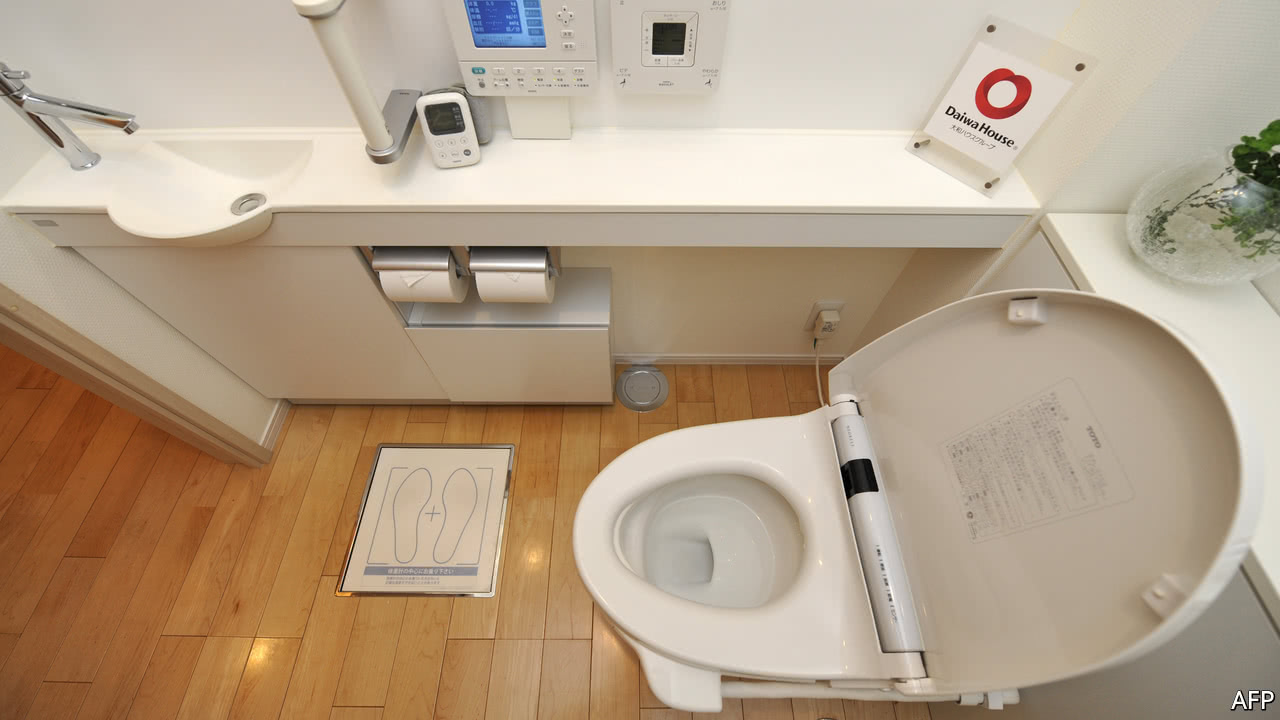
WHEN staff at the Louvre in Paris head to the bathroom, the toilet lid opens as they approach, a warm seat heats their derrières, and, once done, their nether regions are washed and dried precisely. Selling the equipment is a coup for Toto, Japan’s biggest producer of “shower toilets”.
Toto and its rival Lixil carve up the Japanese market for fancy, multi-function loos between them. At home they have market shares of 60% and 30% respectively, according to Nomura Securities, a brokerage. Yet they have struggled to win foreign bottoms over to luxuries enjoyed in Japan for many decades.
Today 26% of Toto’s and 30% of Lixil’s revenues come from abroad (much of it from products other than shower toilets). The Japanese market is profitable, but their loos are already ubiquitous there (including in public facilities, from Tokyo’s metro system to remote hiking trails); the majority of domestic sales come from the renovation of private homes and hotels. And whereas Japan’s population is declining, in other countries sanitaryware is a rapidly growing market as people get richer, says Daisuke Fukushima of Nomura Securities.
But it is not an easy sell abroad. In Japan, shower toilets appeal because of their heated seats in dwellings that are usually kept cold, and due to a Japanese obsession with hygiene and a horror of inconveniencing others (some models play music to hide noises). Other cultures are less stringent. And the toilets are expensive; Toto’s “Neorest” model ranges in price from ¥270,000-¥540,000 ($2,365-$4,730), before tax.
Toto and Lixil differ in their approaches to these challenges. Toto is expanding under its own name, opening showrooms and getting its loos into hotels and buildings where lots of people will see them. “People have to experience it to want to buy it,” says Madoka Kitamura, its president, who wants to create “Toto fans”. In contrast, Lixil, formed in 2011 by a merger of five Japanese companies, is buying foreign competitors. In 2013 it acquired American Standard and a year later Grohe, a German bathroom-fittings giant. It sells a high-tech toilet under the Grohe brand.
Lixil’s strategy is sensible. It does not have quite the same brand recognition as Toto. Kinya Seto, its president, who took over last year, readily admits that Toto currently betters it abroad as well as at home. He is trying to make the company a little less Japanese, whereas Toto is more culturally conservative (a motto, “take pride in your work and strive to do your best,” is recited by every worker in every factory every day to aid team-building). Mixing Japanese technology and Grohe’s European design could give the smaller firm an edge.
Lixil is also casting its net wider in terms of products. Toto is putting more emphasis on those that are not available abroad—meaning high-tech lavatories. In some countries, such as India, Lixil is selling (and donating) basic, cheap kit—plastic pans to use with pit latrines—betting that in several years people will get richer and upgrade.
No market can match the potential of China, yet many mainlanders opt for products from lower down the price range. So for near-term profits, the two companies are looking to America and Europe. There they encounter obstacles such as strict regulations (on water use, say), an absence of sockets in bathrooms and the lack of a “wet culture” beyond southern Europe.
But Toto’s positioning of its toilets in America as better for the environment is going down well. And Lixil launched a new Grohe-branded shower toilet worldwide last year which is selling particularly well in Germany. It is designed to look good from the side (Japanese toilets are usually in a separate tiny room, so are seen only from above) and is made from ceramic (in Japan plastic seats are the norm). Aficionados will be glad that other features, such as a remote-control panel with multiple buttons and anatomical diagrams, remain the same.
Source: economist
Japan’s top two lavatory-makers are at last making inroads overseas